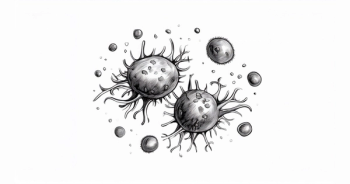
Analysis Finds TP53 Mutation Associated With Poorer Survival in Mantle Cell Lymphoma
According to a multivariate analysis of the Nordic MCL2 and MCL3 trials, the presence of <em>TP53</em> mutations predicts overall survival in younger patients with mantle cell lymphoma.
Christian Winther Eskelund, MD
According to a multivariate analysis of the Nordic MCL2 and MCL3 trials, the presence ofTP53mutations predicts overall survival (OS) in younger patients with mantle cell lymphoma (MCL).
Patients withTP53mutations had a median overall survival (OS) of 1.8 years, a median PFS of 0.9 years, and a median time to relapse of 1.0 year. This compared to not reached, 10.2 years, and 12.3 years, respectively, in patients not harboringTP53mutations.
InTP53-deleted patients, median OS was 8.0 years, and PFS and time to relapse were both 3.1 years.
TP53mutations were an independent predictor for poorer OS (hazard ratio [HR], 6.2;P<.0001). MIPI-c high-risk was an independent predictor for time to relapse (HR, 2.6;P= .003).
“TP53-mutated MCL represents a phenotypically distinct and highly aggressive disease entity with poor or no response to the high-dose regimens including cytarabine, rituximab and [autologous stem-cell transplant],” first author Christian W. Eskelund, MD, Copenhagen University Hospital, Rigshospitalet, and coinvestigators wrote. “Thus, we suggest stratification of MCL patients according toTP53mutational status and inclusion in separate clinical trials exploring novel targeted agents.”
Investigators reviewed data collected in Nordic MCL2 (2000-2005) and Nordic MCL3 (2005-2009). All patients included in this analysis (N = 319) were treated with an intensified frontline regimen that included cytarabine, rituximab (Rituxan), and consolidation with high-dose therapy and autologous stem-cell transplant. Patients with available minimal residual disease (MRD) marker were monitored during follow-up and treated preemptively with rituximab upon MRD-positivity without concurrent clinical relapse.
Median age was 57 years (range, 29-65), 76% of patients were male, 51% were MIPI high- or intermediate-risk, 18% had blastoid morphology, and 41% had Ki67 ≥30%.
Investigators performed genomic studies on diagnostic bone marrow samples from 183 patients. Of these, deletions were analyzed in 177 patients, mutations in 176, and both in 170.
Of patients withTP53mutations, 19 carried 1 mutation, while 1 patient carried 2. Of the 21 detected mutations, 16 were missense mutations in the DNA binding domain.
At a median follow-up of 9.2 years for all 319 patients, median OS was 12.5 years and median PFS was 8.2 years. Half of all patients had relapsed at 10.2 years. Investigators found that blastoid morphology, Ki67 ≥30%, and higher MIPI and MIPI-c risk groups were significantly more likely to experienced poorer outcomes. There was no difference in outcomes among patients with or without bone marrow involvement by morphological review.
Investigators found deletions ofCDKN2Awere detected 20% of patients, deletions of TP53 in 16%, and both deletions were detected in 7%. In total, deletion of either gene was detected in 30% of patients. The applied method did not discriminate between homo- and heterozygous deletions.
By targeted sequencing of 8 genes recurrently mutated in MCL, investigators detected a total of 154 mutations in the 176 patient samples examined. The most commonly mutated genes wereATM(27%),KMT2D(14%), TP53 (11%), andCCND1(9%). Just over half of patients carried at least 1 mutated gene and 19% carried <1 mutated gene.
While onlyTP53mutations showed independent prognostic impact for OS, bothTP53mutations (HR, 6.8;P<.0001) and MIPI-c high-risk (HR, 2.2;P=.01) were predictors for progression-free survival (PFS). Similarly,TP53mutations (HR, 6.9;P<.0001) and MIPI-c high-risk (HR, 2.6;P=.003) were also independent predictors for cumulative incidence of relapse.
CombiningTP53mutations and deletions in the multivariate analyses also showed significant prognostic value for OS (HR, 3.1;P= .0004), PFS (HR, 2.8;P<.0001), and cumulative incidence of relapse (HR, 3.1;P<.0001). Inclusion of the combinedNOTCH1andNOTCH2mutations did not change the multivariate results. MIPI high-risk and Ki67 ≥30% included as separate values did not show independent prognostic value.
The presence ofTP53mutations was significantly associated withNOTCH1mutations (P= .0002), deletions of CDKN2A (P= .0002), andTP53deletions (P= .001).
Reference:
Eskelund CW, Dahl C, Hansen JW, et al.TP53mutations identify younger mantle cell lymphoma patients who do not benefit from intensive chemotherapy [published online August 17, 2017].Blood. doi: 10.1182/blood-2017-04-779736.









































